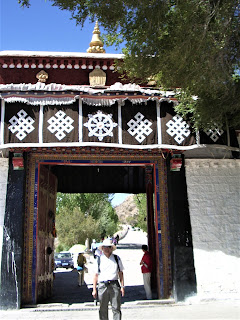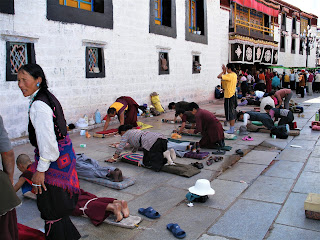TIBET JUNE 2007
DAY 5
Jun 8
LHASA
Lhasa is
the capital of Tibet with an altitude of 3700m above sea level.
Barkhor
Square is a large public square popular with both local and tourists. Jokhang
Temple and Barkhor Streets all are situated here. There are many shops selling
Tibetan crafts.
Johkang
Temple is a Tibetan Buddhist temple built in 647AD. The name Jokhang means
House of Buddha. This is one of the holiest destinations for Buddhist pilgrims.
Lots of pilgrims travelled long distances and prayed in front of the temple.
The temple incorporated Tibetan, Tang Chinese, Nepalese and Indian architecture
and craftsmanship. The temple is located in the popular Barkhor Square.
Barkhor
Street is a place where Tibetan culture, economy, religion and arts assemble.
It is a place that pilgrims tramped out around Jokhang Temple over the
centuries and the pilgrims walked along the circular street clockwise.
The
highlight of Tibet tour is a visit to Potala Palace. Potala
Palace is a UNESCO World Heritage Site. In order
to cater for the large number of visitors, visitors are allowed for 2 hours inside
the palace and walk within the palace on prescribed route. It is 117m high with 13 stories. Photography
is strictly prohibited within the temple.
The photos
were taken on the way up to this majestic temple. Due to high altitude, we had
to take slow and small steps without running out of oxygen. Up here we had a
panoramic view of the city of Lhasa.
We witnessed a construction brigade of women manually pounding a compound with singing and synchronized steps.
Descending
from the palace

The Potala Palace, winter palace of the Dalai Lama since the
7th century, symbolizes Tibetan Buddhism and its central role in the traditional
administration of Tibet.
Enclosed within massive walls, gates and turrets built of rammed earth and stone the White and Red Palaces and ancillary buildings of the Potala Palace rise from Red Mountain in the centre of Lhasa Valley at an altitude of 3,700 metres. As the winter palace of the Dalai Lama from the 7th century CE the complex symbolizes Tibetan Buddhism and its central role in the traditional administration of Tibet. The White Palace contains the main ceremonial hall with the throne of the Dalai Lama, and his private rooms and audience hall are on the uppermost level. The palace contains 698 murals, almost 10,000 painted scrolls, numerous sculptures, carpets, canopies, curtains, porcelain, jade, and fine objects of gold and silver, as well as a large collection of sutras and important historical documents. To the west and higher up the mountain the Red Palace contains the gilded burial stupas of past Dalai Lamas. Further west is the private monastery of the Dalai Lama, the Namgyel Dratshang.(UNESCO write up)
.In the evening, we had dinner at a beautiful restaurant

























































































No comments:
Post a Comment